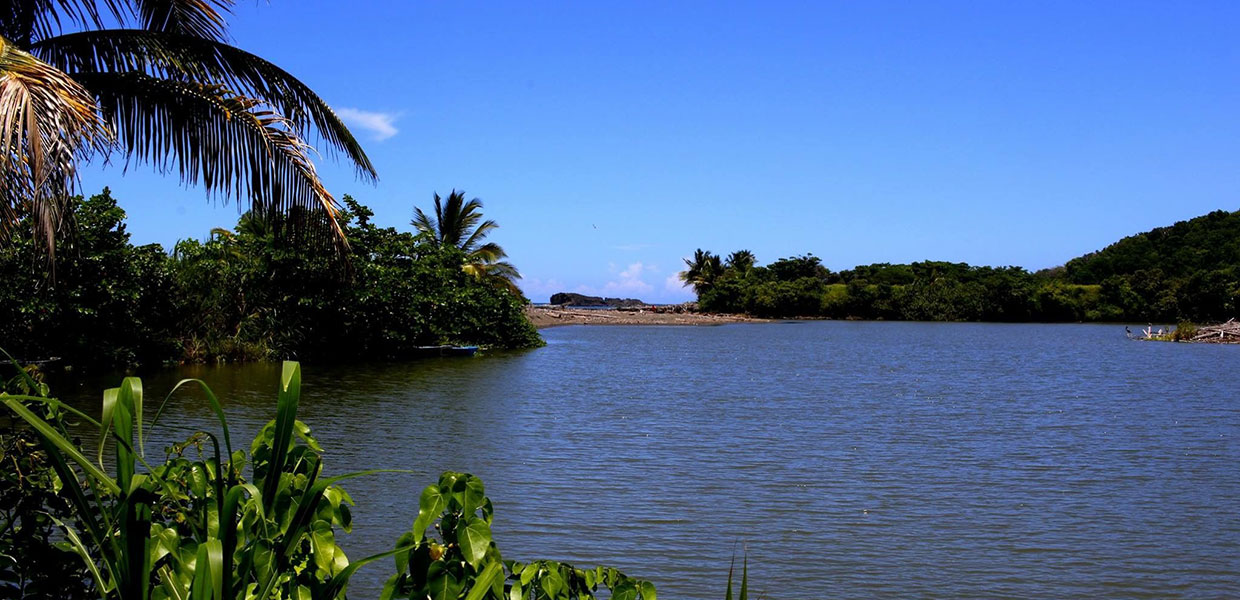
Barceloneta, Puerto Rico
Industrial City
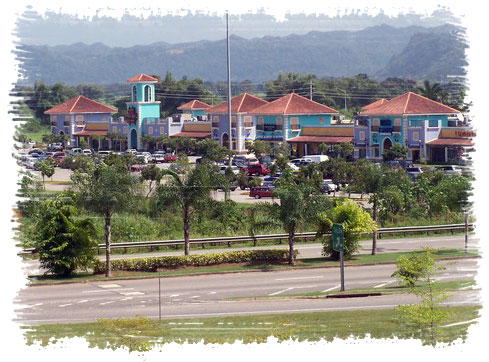 Barceloneta is known as “The Industrial City” and “The Home Town of Sixto Escobar.” The Patron Saint is Our Lady of Mount Carmel and the festival in her honor is celebrated in July. Barceloneta is rich in tradition and boasts an extensive literary and musical folklore. Its trovadores and improvisadores (traditional folk singers and improvisers) perform a ten-line verse form called décimas campesinas, religious or patriotic themes being the most popular.
Barceloneta is known as “The Industrial City” and “The Home Town of Sixto Escobar.” The Patron Saint is Our Lady of Mount Carmel and the festival in her honor is celebrated in July. Barceloneta is rich in tradition and boasts an extensive literary and musical folklore. Its trovadores and improvisadores (traditional folk singers and improvisers) perform a ten-line verse form called décimas campesinas, religious or patriotic themes being the most popular.
Barceloneta is located on the north central coast of the Island. It is bordered on the north by the Atlantic Ocean, on the south by the municipality of Florida, on the east by Manatí, and on the west by Arecibo. The northernmost part lies in the region known as the northern coastal plains.
The town has several waterways: the Río Grande de Manatí, the Quebrada Cimarrona, and the Tiburones and Matos rivers; all of which flow into the Atlantic. Coastal features include the Palmas Altas Promontory and the Tres Hermanas keys.
Barceloneta’s economy is centered on the chemical and pharmaceutical industry. It is one of the most industrialized towns on the Island, and has the highest concentration per square mile of this type of industry in the world. In agriculture, Barceloneta is an important pineapple producer.
Foundation:
Among the youngest towns of the island, the city of Barceloneta was founded the July 1, 1881. It was one of the last municipalities created by the Spanish government in Puerto Rico. Its founder was Don Bonocio Lenza Feliú.
Barceloneta was named in honor of Barcelona (city of Spain) where the founder was born. Thirteen years after its foundation it experienced great agricultural and industrial development with 3 sugar cane plantations, 93 coffee plantations and 100 fruit farms.
Location:
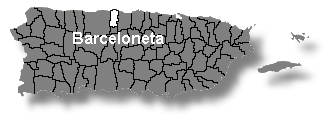 Located in the North coast, it is bordered by: the Atlantic Ocean on the north, the city of Florida on the south, Arecibo on the west, and Manatí on the east.
Located in the North coast, it is bordered by: the Atlantic Ocean on the north, the city of Florida on the south, Arecibo on the west, and Manatí on the east.
Area:
62.0 sq km / 24.0 sq mi
Population:
22,322 (census 2000)
Population Density:
360.0 per sq km / 930.0 per sq mi
People are known as:
Barcelonetenses
Barceloneta is also known as:
Tomás Dávila Martínez (Industrial City)
La Ciudad de las Piñas (The Pineapple City)
El Pueblo de los Indios (The Indian City)
El Pueblo de Sixto Escobar (Sixto Escobar’s City)
Wards: Barceloneta, Puerto Rico

| Census 2000: Population by Wards – Barceloneta | Habitants |
| Barceloneta Town | 277 |
| Florida Afuera | 12,969 |
| Garrochales | 5,201 |
| Palmas Altas | 3,875 |
| Total | 22,322 |
Información: Source: Censo 2000
Patron:
Nuestra Señora del Carmen
Parroquia Nuestra Señora del Carmen
47 Georgetti Barceloneta
Barceloneta, Puerto Rico
Tel. (787) 846-5625
Horario de Misas
Diario: Martes y miércoles 7:00 p.m. Jueves 8:00 a.m.
Sábados: 7:30 p.m. | Domingos: 7:00 a.m. y 11:00 a.m.m
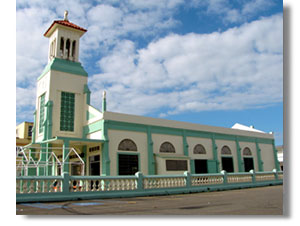
Topography:
The terrian is mainly level. Because it is in the karst zone the terrain has many wooded hills and caves typical of the karst zones.
Hydrography:
The Grande de Manatí river is 73 kilometers (45 miles) in length and lies between the municipalities of Manatí and Barceloneta and ends at the Atlantic Ocean. Also part of the hydrography is El Caño Tiburones, the most extensive marshland of the island and second most extensive of the Caribbean, covering 2,266 hectares.
Climate:
Precipitation is approximately 53.01 inches and the annual average temperature is 77.8°F.
Economy:
It has the greatest pharmaceutical complex in the world (14 industries). These industries choose Barceloneta to establish their companies because of its vast underground water deposits. The water in Barceloneta is so pure that it requires very little treatment for the manufacture of pharmaceutical products. In addition to the pharmaceutical industry it counts with numerous factories dedicated to the manufacture of textiles, food, chemicals, plastics, electronic instruments, communications and scientific equipment.
Average Salary:
$528.24 weekly (1998)
Flag:
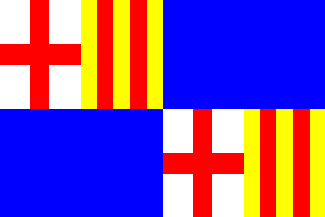 The Municipal Assembly adopted the flag following ordinance No. 21, May 31, 1979. Roberto Biascochea Lota, Special Consultor in Heraldic Matters to the Puerto Rican Institute of Culture and Special Assistance to the Director, designed the flag. The flag is a rectangular adaptation of the former Coat of Arms, as are its colors, with the variation of omitting the flowers of “guajana” (sugar cane flower) and that the blazon’s gold and silver are substituted by yellow and white, respectively.
The Municipal Assembly adopted the flag following ordinance No. 21, May 31, 1979. Roberto Biascochea Lota, Special Consultor in Heraldic Matters to the Puerto Rican Institute of Culture and Special Assistance to the Director, designed the flag. The flag is a rectangular adaptation of the former Coat of Arms, as are its colors, with the variation of omitting the flowers of “guajana” (sugar cane flower) and that the blazon’s gold and silver are substituted by yellow and white, respectively.
The flag of Barceloneta derives from the Catalonian flag, the autonomous region of Spain which has Barcelona as it’s capital. Barceloneta is the name of Barcelona’s famous beach, and the original settlers of this Puerto Rican town were Catalan immigrants to Puerto Rico. The cross represents the flag of Saint George, one of the patron saints of Catalonia (along with Our Lady of Montserrat).
Coat Of Arms:
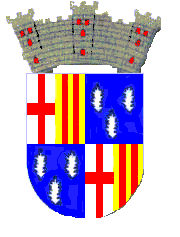 This shield was approved by the Municipal Assembly by decree #21, 31 May, 1979. The sugar cane flowers (guajanas) symbolize the source of life of the old agricultural economy of Barceloneta. The blue symbolizes the beaches and marine ports of great importance for industry and commerce. Its crown consists of three towers.
This shield was approved by the Municipal Assembly by decree #21, 31 May, 1979. The sugar cane flowers (guajanas) symbolize the source of life of the old agricultural economy of Barceloneta. The blue symbolizes the beaches and marine ports of great importance for industry and commerce. Its crown consists of three towers.
Events:
- Three Kings Children’s Festival – January
- Posthumous Homage to Plácido Acevedo Sosa (director of the Mayarí Quartet) – last Sunday in February
- Las Criollas Beach Festival – June
- Our Lady of Mount Carmel Patron Saint”s Festival– July
- Sixto Escobar Marathon – July
- Folk Festival – October
Places To Visit:
- Las Criollas Beach
- Old City Hall
- Old Rafael Balseiro Maseira School– built in 1921
- Old Christian and Missionary Alliance Church – built in 1908
- José Ignacio Machado Sports Field
- Sixto Escobar Community Library
- Cambalache State Forest
- City Hall
- Barceloneta Cultural Center – includes an archeological museum
- Juan Cancel Ríos Government Center
- Mount La Catalana
- Sixto Escobar Sports Complex and Auditorium
- Villa Georgetti Sports Complex– includes a motocross track, a BMX track, a scooter track, a “gotcha” court, and a tennis court.
- Pharmaceutical Complex
- Cave of the Tamarind trees
- Río Grande de Manatí Estuary
- Roque Island
- Artificial recreational lake – located behind the City Hall and the multi-use building
- Our Lady of Mount Carmel Parish Church
- El Ancón Plaza- named for a means of transportation; a small barge-type boat used to cross the Río Grande de Manatí
- Benito de Jesús Plaza
- José Cordero Rosario Plaza
- Sixto Escobar Plaza
- Vicente Acevedo Ballester Plaza
- La Palmita Beach
- La Boca Beach
- Puerto de la Vacas Beach
- Ruins of the Plazuela Sugar Mill – sugar mill that became the town’s primary source of economy in the early twentieth century.
- Ernesto Ramos Antonini Theater
- Bonocio Llenza Feliú Hospital
Distinguished Citizens:
- José Agustín Balseiro – Writer. In 1931, Balseiro was unanimously elected to serve as a member of the Royal Academy of the Spanish Language. He is the only Puerto Rican that has ever received this honor. Among his work are the following novels: La ruta eterna and En vela mientras el mundoduerme (Awake While the World Sleeps); and poetry: La copa de Anacreonte (Anacreonte’s Goblet), Música cordial (Cordial Music), and La pureza cautiva (Captive Purity).
- Juan Cancel Ríos, Esq. – Civil servant. Ríos held the following positions: President of the Municipal Council of Barceloneta (1957–1960), Representative, Manatí-Barceloneta district (1961–1964), district of Arecibo senator (1965-1980), vice-president (1969-1972) and president of the Puerto Rico senate (1973-1976).
- Francisco Díaz Marchand, Esq. – Labor leader. Representative for Barceloneta and Manatí (1937-1940 and 1948-1954), author of the álbum histórico y cultural de Barceloneta (Historical and Cultural Album of Barceloneta).
- Sixto Escobar Vargas – Escobar discovered his love of boxing at a very young age. During the course of his successful boxing career he fought 92 fights, of which he won 79, lost 12, and tied one. On June 26, 1934, he won the first world lightweight championship for Puerto Rico, and an avenue in Barceloneta was named after him in honor of this event. In 1950, he was elected to the Boxing Hall of Fame.
- Benito de Jesús Negrón – Composer. Negrón was a member of the following groups: Conjunto Alhoa, Daniel González and his Guitars, and the Trío Vegabajeño (to which he belonged for twenty-four years). For some time he was program director for Rafael Quiñónez Vidal. One of his most notable compositions is “Nuestro Juramento,” which has been recorded in several languages by famous musicians.
- Monsignor Tomás Maisonet – Maisonet was a priest in Humacao and parish priest in Cidra, Río Grande, and the Cathedral of San Juan. He was special secretary to Archbishop James Peter Davis. He was also a United States Army Chaplain for over three years and a National Guard Chaplain for a considerable length of time.
- Blanca María Marchand – Poet known as “the sweetheart of verse”.
- Colita Mercado de Dimas-Aruti – Journalist and writer, Mercado began her journalistic career in 1925. She held several positions, such as secretary of the American Legion in Puerto Rico and secretary of the League of Women Voters. She was a member of the Academia de Ciencias y Letras in Cadiz, Spain, of the International Academy of Journalism, and of the Institute of Literature in France. In Spain she was declared Gran Dama and received the sash representing the Order of Santa Elena. She wrote the following books: Psicología femenina del matrimonio (Feminine Psychology of Marriage) (which was highly praised by literary critics), El ideal de la vida (The Ideal of Life), Por un mundo mejor (For a Better World), and Modelando una estatua (Modeling a Statue).
- Teodoro Moscoso – One of the main innovators of the economic reform movement known as “Operación Manos a la Obra” (“Operation Bootsrap”), basis for the island’s industrialization. In 1950, he drafted the bill that was to orchestrate Puerto Rico’s economic development under the Economic Development Administration, of which he became the first administrator. In 1961, President Kennedy appointed Moscoso United States ambassador in Venezuela. Subsequently, he directed the Alliance for Progress, the organization that channeled financial aid from the United States to Latin America.
- José Antonio “ñin” Pagán – First Puerto Rican to be champion batter in the 1962 World Series when he was playing for the San Francisco Giants; later a Major League and Triple A manager. He won a Caribbean Series as a manager.
Public Schools sorted by educational levels.
Arecibo Region
Barceloneta District
| Name | Level | Telephone | Address |
| Elementary | |||
| AGUSTÍN | K-6 | (787) 846-4379 | PO Box 2048, P.R. 00617-0000 |
| IMBERY | K-6 | (787) 846-0361 | PO Box 2052, P.R. 00617-0000 |
| JESÚS M RIVERA | K-6 | (787) 846-3165 | PO Box 668, P.R. 00617-0000 |
| JOSÉ CORDERO ROSARIO | K-6 | (787) 846-5474 | PO Box 2051, P.R. 00617-0000 |
| PRIMITIVO MARCHAND | K-6 | (787) 846-6509 | PO Box 2048, P.R. 00617-0000 |
| Intermediate | |||
| PRE VOCACIONAL BUFALO | EE | (787) 846-4595 | PO Box 2048, P.R. 00617-0000 |
| RAFAEL BALSEIRO MACEIRA | 7-9 | (787) 846-2460 | PO Box 2074, P.R. 00617-0000 |
| Secondary | |||
| DR. FRANCISCO VÁZQUEZ | K-9 | (787) 846-3171 | PO Box 2053, P.R. 00617-0000 |
| High School | |||
| FERNANDO SURIA CHÁVEZ | 10-12 | (787) 846-6750 | PO Box 2066, P.R. 00617-0000 |
Himno:
Querido Barceloneta By Luis Felipe Román Ramos
Barceloneta, linda esmeralda
Que un día fundara Llenza Feliú,
Hombres valiosos, grandes mujeres
Te han distinguido a plenitud.
Siempre te llevo, Barceloneta,
En lo profundo del corazón
Rincón Boricua, rincón boricua,
Mi terruñito encantador.
En el espejo de tu gran río
Es donde nace la inspiración
Esplendorosa, esplendorosa,
Cual bella rosa de ensoñación.
Tu hermosa playa, Barceloneta,
Tu sol de oro primaveral
Son un regalo, son un regalo
Del Rey Eterno, Dios Celestial.

